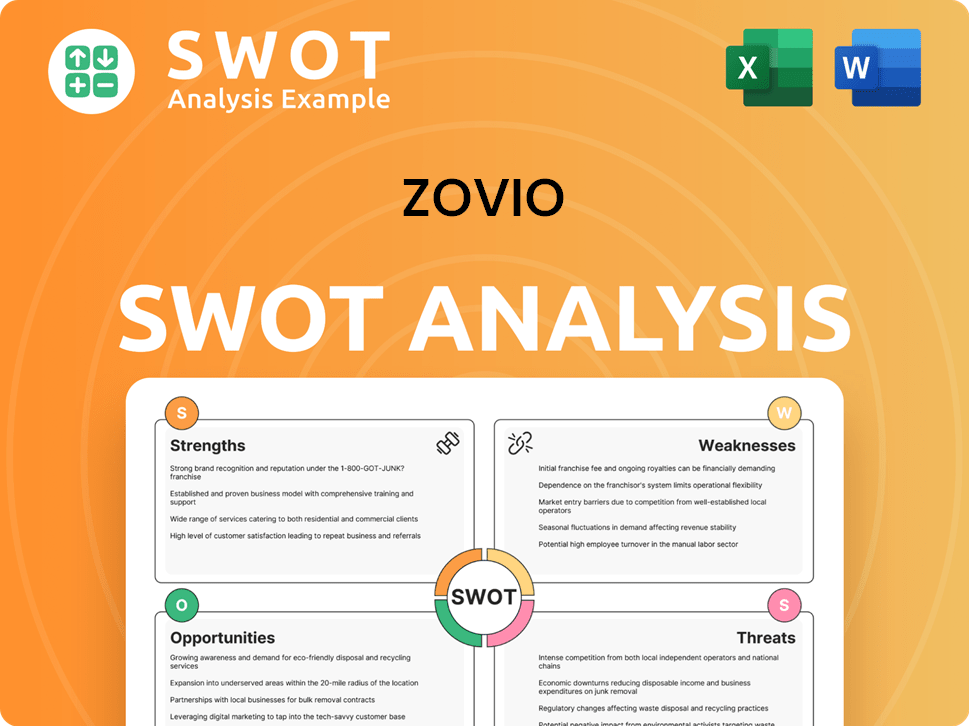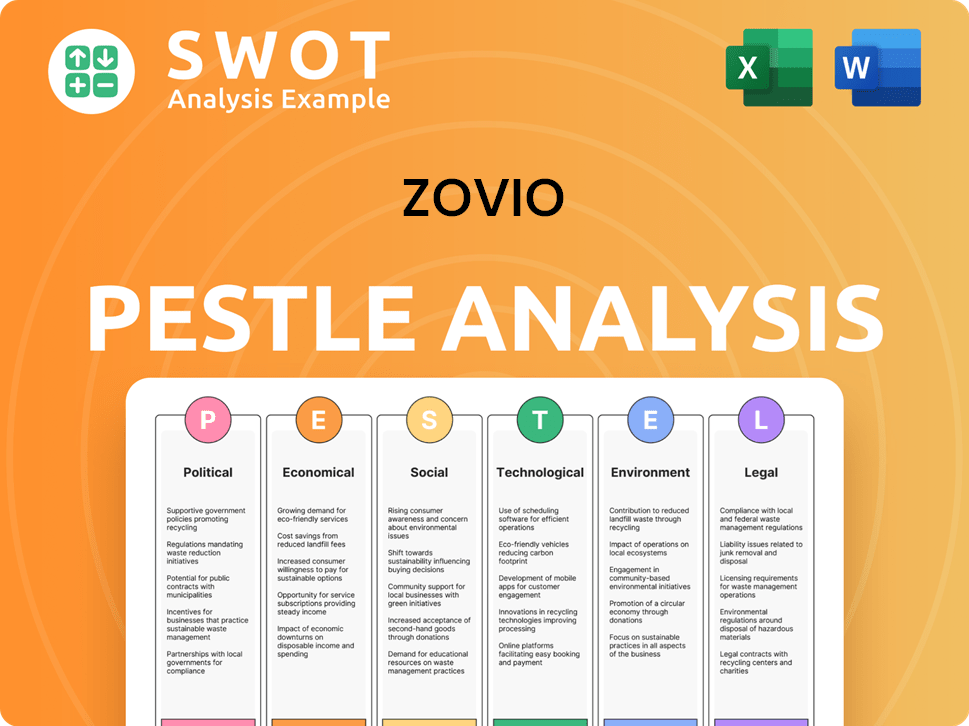Zovio Bundle
What Defined Zovio's Customer and Market?
The higher education sector is undergoing a seismic shift, and understanding the Zovio SWOT Analysis reveals crucial insights into navigating this landscape. With enrollment trends changing, grasping the nuances of customer demographics and target markets is paramount for ed-tech companies. Zovio, a pioneer in online program management, offers a compelling case study in adapting to the evolving needs of both institutions and students.

This analysis will explore Zovio's journey, focusing on its customer demographics and target market, shedding light on its strategic shifts from a B2C to a B2B model. Understanding the company's approach to audience analysis and market segmentation provides valuable lessons for anyone interested in the ed-tech industry. We'll delve into the characteristics of Zovio's target customers, examining their needs and preferences in the competitive online program management space, and how Zovio business adapted to those needs.
Who Are Zovio’s Main Customers?
Understanding the customer demographics and target market of the company involves analyzing its shift from a direct-to-consumer model to a business-to-business (B2B) service provider. Initially, the company operated in the higher education sector, directly serving students through its own institution. However, a strategic pivot led to a focus on providing services to other educational institutions.
The primary target market for the company became higher education institutions. These institutions, including universities and online campuses, sought the company's expertise in online program management (OPM), curriculum development, and student support. This B2B model was driven by the increasing demand for flexible education and a growing market for online program management services.
The company's evolution reflects broader trends in the education technology sector. The online program management market was valued at USD 16.62 billion in 2024, demonstrating the significant opportunity for companies providing services to educational institutions. This shift allowed the company to leverage its technological capabilities and data analytics to serve a broader range of higher education institutions seeking to improve their online presence and student outcomes. For more information about the competitive landscape, you can check out the Competitors Landscape of Zovio.
The company's institutional clients varied significantly, reflecting the diversity of higher education institutions. These clients included traditional universities and online-focused campuses looking to expand their online offerings. The company provided services to help these institutions with student recruitment, retention, and curriculum development.
The increasing demand for flexible and accessible education drove the need for online program management services. This demand was fueled by potential students seeking workforce entry or higher education at later stages of life. The company's services were designed to meet these evolving needs in the education sector.
The transition from a direct-to-consumer model to an institutional partnership model was influenced by regulatory scrutiny and strategic decisions. The sale of its own university and the focus on service agreements with institutions like the University of Arizona Global Campus (UAGC) exemplified this shift. This strategic change allowed the company to focus on its core competencies in education technology.
The company provided a range of services, including student recruitment and enrollment systems, retention strategies, educational tools, and curriculum development. These services were designed to help higher education institutions improve their online presence and student outcomes. The company's focus on technology and data analytics was key to its service offerings.
The target market of the company consisted of higher education institutions seeking to enhance their online programs. These institutions were driven by the need to meet the growing demand for online education and improve student outcomes. The company's services were tailored to address these specific needs within the higher education sector.
- Higher education institutions (universities, online campuses)
- Demand for online program management (OPM) services
- Focus on student recruitment and retention
- Curriculum development and educational tools
Zovio SWOT Analysis
- Complete SWOT Breakdown
- Fully Customizable
- Editable in Excel & Word
- Professional Formatting
- Investor-Ready Format

What Do Zovio’s Customers Want?
Understanding the needs and preferences of its customers, primarily higher education institutions, was crucial for Zovio. The company's success hinged on addressing the evolving demands of online learning and the broader challenges faced by the higher education sector. This involved a deep dive into the customer demographics and target market to tailor services effectively.
A significant driver for institutions was the need for flexible and accessible education solutions. This was particularly important for non-traditional students, working professionals, and those seeking reskilling opportunities. Institutions sought partners like Zovio to expand their reach and cater to diverse learners. The online program management market is projected to reach USD $101.82 billion by 2034, highlighting the growth potential in this area.
Purchasing behaviors and decision-making criteria for these institutions often centered on enhancing the learner experience, improving student outcomes, and achieving operational effectiveness. Zovio addressed pain points such as student recruitment, enrollment, and retention challenges, which were key considerations.
Institutions prioritized solutions that improved student outcomes and operational efficiency. Zovio's 'Signalz for Student Success' used predictive analytics to identify at-risk students, directly addressing the critical need for student retention. Undergraduate enrollment is predicted to decline from 2025 onwards, making retention even more crucial.
- Flexibility and Accessibility: Demand for online programs catering to diverse learners.
- Enhanced Learner Experience: Focus on improving student outcomes through data-driven insights.
- Operational Effectiveness: Seeking solutions to streamline processes and reduce in-house burdens.
- Technological Advancement: Accessing advanced technology solutions for online program management.
Zovio PESTLE Analysis
- Covers All 6 PESTLE Categories
- No Research Needed – Save Hours of Work
- Built by Experts, Trusted by Consultants
- Instant Download, Ready to Use
- 100% Editable, Fully Customizable

Where does Zovio operate?
The geographical market presence of Zovio was primarily concentrated within the United States. The company strategically partnered with higher education institutions across various states, focusing its operations domestically. This approach allowed Zovio to leverage the significant growth in the U.S. online education market.
Zovio's headquarters relocation from San Diego, California, to Chandler, Arizona, in 2019, further solidified its operational base within the U.S. This move was driven by factors such as access to local talent and a favorable business environment. The company's services, particularly its online program management, inherently transcended strict geographical boundaries, enabling institutions to reach a broad national audience.
The company's focus on technology and services for online delivery aimed to provide scalable solutions adaptable to various institutional contexts. This was particularly relevant as the online education market in the U.S. continued to expand. In 2024, over six million students were pursuing higher education fully online, representing a substantial market for companies like Zovio.
Zovio's operations were largely centered in the United States, reflecting its strategic focus on the domestic market. The move to Chandler, Arizona, further concentrated its operational base within the country. This geographic focus allowed the company to capitalize on the growing demand for online education within the U.S.
The company offered online program management services, which inherently extended its reach beyond strict geographical limits. This allowed institutions to attract a broader audience across the nation. The online education market's growth provided a significant opportunity for Zovio to expand its services.
Zovio's technology and service offerings were designed to be adaptable to various institutional needs. This approach was crucial for serving diverse student populations across different regions. The ability to adapt to state-level regulations and regional educational trends was key to its market strategy.
The sale of Ashford University in 2020 marked a strategic shift towards a pure-play education technology services provider. This change reflected industry trends and the evolving needs of institutions. This shift allowed Zovio to focus on its core competencies in providing online program management.
Understanding Zovio's customer demographics, including their geographic location, is crucial for effective market segmentation. Owners & Shareholders of Zovio can benefit from analyzing these factors to refine their strategies. Analyzing Zovio's customer base involves identifying key market segments and understanding the characteristics of their target customers.
- The primary geographical focus was the United States, with a national reach through online programs.
- Regional differences in customer preferences and buying power were influenced by state-level regulations and educational trends.
- The company's services were designed to be scalable and adaptable to various institutional contexts across different regions.
- The strategic shift towards a pure-play education technology services provider influenced the company's market focus.
Zovio Business Model Canvas
- Complete 9-Block Business Model Canvas
- Effortlessly Communicate Your Business Strategy
- Investor-Ready BMC Format
- 100% Editable and Customizable
- Clear and Structured Layout

How Does Zovio Win & Keep Customers?
The company, formerly known as, employed a strategic approach to customer acquisition and retention. Its primary focus was on higher education institutions seeking to enhance their online learning capabilities. This involved a business-to-business (B2B) sales strategy targeting universities and colleges, offering a suite of services designed to improve online program management and student outcomes. This approach is crucial for understanding the Marketing Strategy of Zovio.
Customer acquisition centered on forming partnerships with universities. These partnerships provided solutions like online program management, curriculum development, and student support. The company aimed to attract institutions looking for tailored and data-driven approaches to online education. This strategy likely involved direct outreach, industry conferences, and showcasing successful case studies.
For retention, the company focused on providing ongoing support and demonstrating value through its technology and services. The company's offerings, such as the faculty management system (FMS) for faculty onboarding and professional development, and curriculum feedback tools like Waypoint Outcomes, were designed to integrate deeply with institutional operations and improve the overall learning experience.
The company's acquisition strategy primarily involved partnering with universities and colleges. This B2B approach focused on offering comprehensive solutions to enhance online learning capabilities. Direct outreach, industry conferences, and showcasing successful case studies were likely key components of this strategy.
Retention efforts centered on providing ongoing support and demonstrating value through technology and services. The company offered tools like the faculty management system (FMS) and curriculum feedback tools. These were designed to integrate with institutional operations and improve the learning experience.
The company aimed to leverage data to enhance the learner experience and deliver strong outcomes for its partners. While specific CRM systems or detailed segmentation strategies are not publicly elaborated upon, the nature of their services suggests a strong reliance on understanding the unique needs and challenges of each institutional client to tailor their solutions.
The shift from owning Ashford University to becoming a pure education technology services provider impacted acquisition and retention. This allowed the company to focus on a broader market of higher education institutions. However, the cessation of operations in September 2022 indicates challenges in maintaining its business model.
The company's approach included B2B partnerships, ongoing support, and data-driven solutions. The goal was to improve student outcomes and operational efficiency for partner institutions. The launch of 'Signalz for Student Success' in 2020, which utilized AI-powered predictive analytics to identify and support at-risk learners, exemplifies the company's commitment to student retention, a crucial factor for its partner institutions.
- Partnerships: Forming alliances with universities for comprehensive online program management.
- Technology: Utilizing tools like the faculty management system (FMS) and curriculum feedback tools.
- Data Analytics: Implementing AI-powered predictive analytics for student success.
- Focus: Improving student engagement and retention.
Zovio Porter's Five Forces Analysis
- Covers All 5 Competitive Forces in Detail
- Structured for Consultants, Students, and Founders
- 100% Editable in Microsoft Word & Excel
- Instant Digital Download – Use Immediately
- Compatible with Mac & PC – Fully Unlocked

Related Blogs
- What are Mission Vision & Core Values of Zovio Company?
- What is Competitive Landscape of Zovio Company?
- What is Growth Strategy and Future Prospects of Zovio Company?
- How Does Zovio Company Work?
- What is Sales and Marketing Strategy of Zovio Company?
- What is Brief History of Zovio Company?
- Who Owns Zovio Company?
Disclaimer
All information, articles, and product details provided on this website are for general informational and educational purposes only. We do not claim any ownership over, nor do we intend to infringe upon, any trademarks, copyrights, logos, brand names, or other intellectual property mentioned or depicted on this site. Such intellectual property remains the property of its respective owners, and any references here are made solely for identification or informational purposes, without implying any affiliation, endorsement, or partnership.
We make no representations or warranties, express or implied, regarding the accuracy, completeness, or suitability of any content or products presented. Nothing on this website should be construed as legal, tax, investment, financial, medical, or other professional advice. In addition, no part of this site—including articles or product references—constitutes a solicitation, recommendation, endorsement, advertisement, or offer to buy or sell any securities, franchises, or other financial instruments, particularly in jurisdictions where such activity would be unlawful.
All content is of a general nature and may not address the specific circumstances of any individual or entity. It is not a substitute for professional advice or services. Any actions you take based on the information provided here are strictly at your own risk. You accept full responsibility for any decisions or outcomes arising from your use of this website and agree to release us from any liability in connection with your use of, or reliance upon, the content or products found herein.